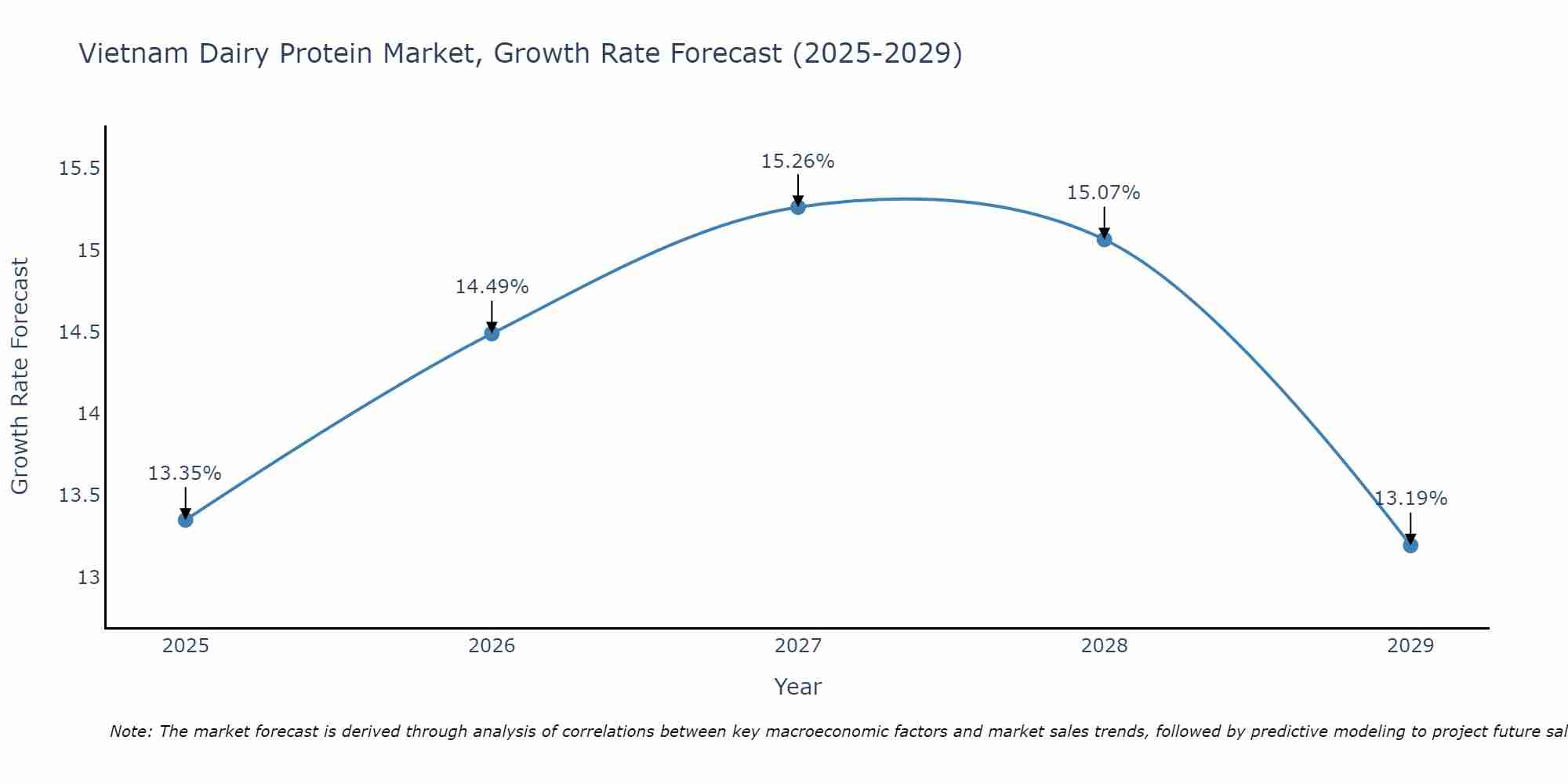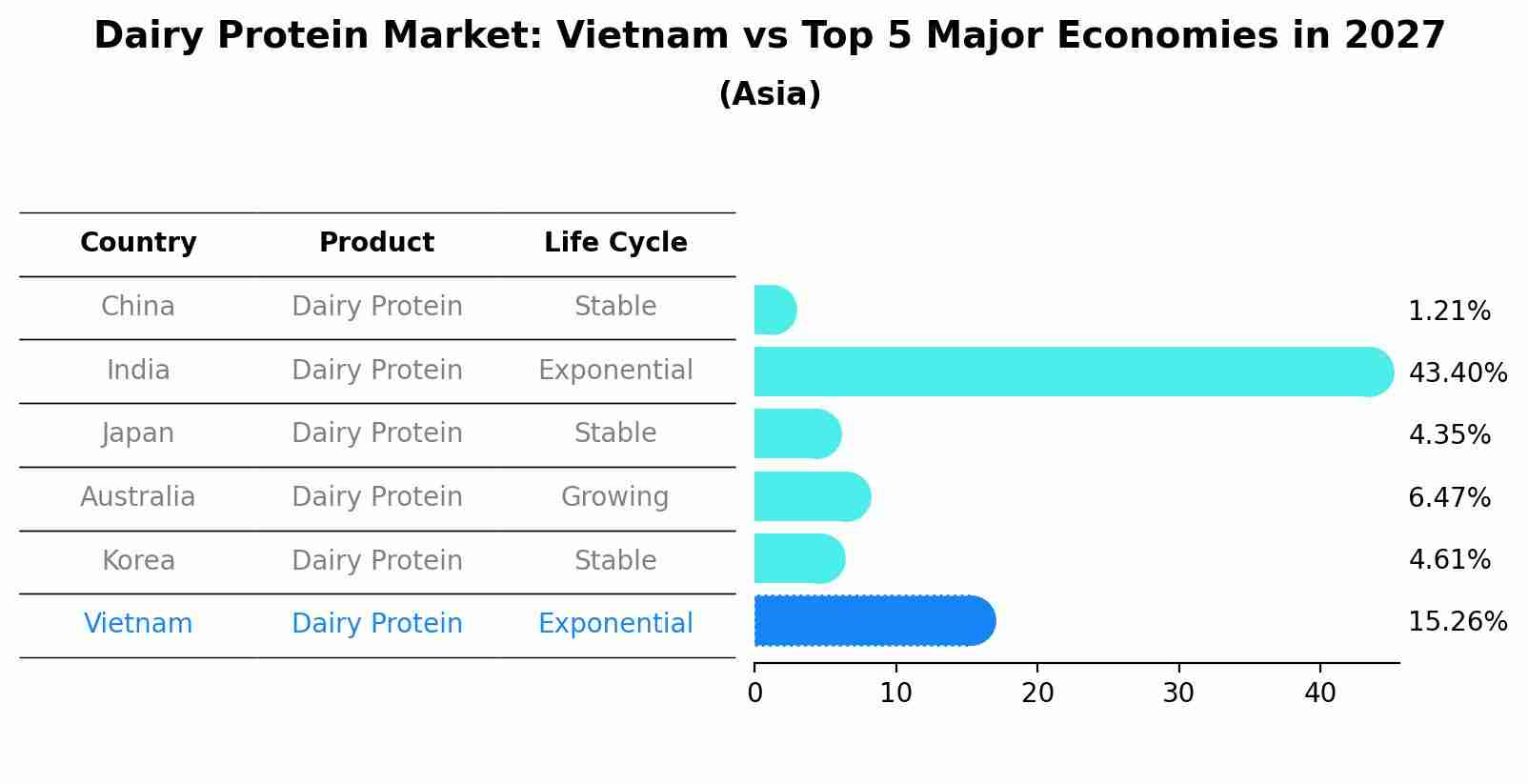Vietnam Dairy Protein Market (2025-2031) Outlook | Growth, Trends, Share, Forecast, Size, Analysis, Industry, Value, Companies & Revenue
| Product Code: ETC187782 | Publication Date: May 2022 | Updated Date: Aug 2025 | Product Type: Market Research Report | |
| Publisher: 6Wresearch | Author: Ravi Bhandari | No. of Pages: 60 | No. of Figures: 40 | No. of Tables: 7 |
Vietnam Dairy Protein Market Size Growth Rate
The Vietnam Dairy Protein Market is projected to witness mixed growth rate patterns during 2025 to 2029. The growth rate begins at 13.35% in 2025, climbs to a high of 15.26% in 2027, and moderates to 13.19% by 2029.

Dairy Protein Market: Vietnam vs Top 5 Major Economies in 2027 (Asia)
By 2027, Vietnam's Dairy Protein market is forecasted to achieve a exponential growth rate of 15.26%, with China leading the Asia region, followed by India, Japan, Australia and South Korea.

Vietnam Dairy Protein Market Overview
As a crucial component of the broader dairy industry, the Vietnam Dairy Protein Market is witnessing robust growth. The market encompasses various dairy protein products, including whey protein and casein, catering to the increasing demand for protein-rich supplements and functional foods. Factors such as rising health consciousness, fitness trends, and the awareness of protein`s role in muscle development drive the demand for dairy protein in the Vietnamese market. The market is characterized by the presence of both domestic and international players offering a diverse range of products to meet evolving consumer preferences.
Drivers of the Market
The Vietnam Dairy Protein Market is thriving due to the growing awareness of the importance of protein in the diet. Dairy proteins, such as whey and casein, are essential ingredients for sports nutrition, supplements, and functional foods. The market benefits from the increasing fitness and health-conscious population, driving the demand for protein-rich products.
Challenges of the Market
The Vietnam dairy protein market faces several challenges, including supply chain issues. The country`s dairy industry has traditionally focused on liquid milk production, and transitioning to higher-value dairy protein products requires significant investment in processing facilities. Quality control and standardization in dairy protein production can also be problematic, as variations in raw milk quality and processing techniques can affect the consistency of the end product. The market must also grapple with consumer preferences for non-dairy alternatives, which are gaining popularity. This trend necessitates innovation and marketing to compete with plant-based alternatives.
COVID 19 Impact on the Market
The Vietnam Dairy Protein market has faced challenges arising from the COVID-19 pandemic. Disruptions in the dairy supply chain, including milk production and processing, have affected the production of dairy protein products. The closure of gyms and fitness centers during lockdowns has also influenced consumer demand for dairy protein supplements. Market players are adapting by exploring online sales channels, focusing on product innovation, and addressing the evolving needs of health-conscious consumers in the post-pandemic landscape.
Key Players in the Market
The Vietnam Dairy Protein market is evolving rapidly, driven by the increasing awareness of the health benefits of dairy proteins. Key players such as Vinamilk and Nestl? are capitalizing on this trend, offering a range of dairy protein products to cater to diverse consumer preferences.
Key Highlights of the Report:
- Vietnam Dairy Protein Market Outlook
- Market Size of Vietnam Dairy Protein Market, 2024
- Forecast of Vietnam Dairy Protein Market, 2031
- Historical Data and Forecast of Vietnam Dairy Protein Revenues & Volume for the Period 2021-2031
- Vietnam Dairy Protein Market Trend Evolution
- Vietnam Dairy Protein Market Drivers and Challenges
- Vietnam Dairy Protein Price Trends
- Vietnam Dairy Protein Porter's Five Forces
- Vietnam Dairy Protein Industry Life Cycle
- Historical Data and Forecast of Vietnam Dairy Protein Market Revenues & Volume By Type for the Period 2021-2031
- Historical Data and Forecast of Vietnam Dairy Protein Market Revenues & Volume By Casein and Derivatives for the Period 2021-2031
- Historical Data and Forecast of Vietnam Dairy Protein Market Revenues & Volume By Whey protein for the Period 2021-2031
- Historical Data and Forecast of Vietnam Dairy Protein Market Revenues & Volume By Milk Protein Concentrate for the Period 2021-2031
- Historical Data and Forecast of Vietnam Dairy Protein Market Revenues & Volume By Application for the Period 2021-2031
- Historical Data and Forecast of Vietnam Dairy Protein Market Revenues & Volume By Food & Beverages for the Period 2021-2031
- Historical Data and Forecast of Vietnam Dairy Protein Market Revenues & Volume By Nutrition for the Period 2021-2031
- Historical Data and Forecast of Vietnam Dairy Protein Market Revenues & Volume By Personal Care & Cosmetics for the Period 2021-2031
- Historical Data and Forecast of Vietnam Dairy Protein Market Revenues & Volume By Feed for the Period 2021-2031
- Historical Data and Forecast of Vietnam Dairy Protein Market Revenues & Volume By Others for the Period 2021-2031
- Historical Data and Forecast of Vietnam Dairy Protein Market Revenues & Volume By Form for the Period 2021-2031
- Historical Data and Forecast of Vietnam Dairy Protein Market Revenues & Volume By Solid for the Period 2021-2031
- Historical Data and Forecast of Vietnam Dairy Protein Market Revenues & Volume By Liquid for the Period 2021-2031
- Vietnam Dairy Protein Import Export Trade Statistics
- Market Opportunity Assessment By Type
- Market Opportunity Assessment By Application
- Market Opportunity Assessment By Form
- Vietnam Dairy Protein Top Companies Market Share
- Vietnam Dairy Protein Competitive Benchmarking By Technical and Operational Parameters
- Vietnam Dairy Protein Company Profiles
- Vietnam Dairy Protein Key Strategic Recommendations
Frequently Asked Questions About the Market Study (FAQs):
1 Executive Summary |
2 Introduction |
2.1 Key Highlights of the Report |
2.2 Report Description |
2.3 Market Scope & Segmentation |
2.4 Research Methodology |
2.5 Assumptions |
3 Vietnam Dairy Protein Market Overview |
3.1 Vietnam Country Macro Economic Indicators |
3.2 Vietnam Dairy Protein Market Revenues & Volume, 2021 & 2031F |
3.3 Vietnam Dairy Protein Market - Industry Life Cycle |
3.4 Vietnam Dairy Protein Market - Porter's Five Forces |
3.5 Vietnam Dairy Protein Market Revenues & Volume Share, By Type, 2021 & 2031F |
3.6 Vietnam Dairy Protein Market Revenues & Volume Share, By Application, 2021 & 2031F |
3.7 Vietnam Dairy Protein Market Revenues & Volume Share, By Form, 2021 & 2031F |
4 Vietnam Dairy Protein Market Dynamics |
4.1 Impact Analysis |
4.2 Market Drivers |
4.2.1 Increasing consumer awareness about health benefits of dairy protein |
4.2.2 Growing disposable income leading to higher spending on dairy products |
4.2.3 Rising demand for functional foods and beverages with added protein content |
4.3 Market Restraints |
4.3.1 Fluctuating raw material prices affecting production costs |
4.3.2 Intense competition among dairy protein manufacturers |
4.3.3 Regulatory challenges and compliance requirements in the dairy industry |
5 Vietnam Dairy Protein Market Trends |
6 Vietnam Dairy Protein Market, By Types |
6.1 Vietnam Dairy Protein Market, By Type |
6.1.1 Overview and Analysis |
6.1.2 Vietnam Dairy Protein Market Revenues & Volume, By Type, 2021-2031F |
6.1.3 Vietnam Dairy Protein Market Revenues & Volume, By Casein and Derivatives, 2021-2031F |
6.1.4 Vietnam Dairy Protein Market Revenues & Volume, By Whey protein, 2021-2031F |
6.1.5 Vietnam Dairy Protein Market Revenues & Volume, By Milk Protein Concentrate, 2021-2031F |
6.2 Vietnam Dairy Protein Market, By Application |
6.2.1 Overview and Analysis |
6.2.2 Vietnam Dairy Protein Market Revenues & Volume, By Food & Beverages, 2021-2031F |
6.2.3 Vietnam Dairy Protein Market Revenues & Volume, By Nutrition, 2021-2031F |
6.2.4 Vietnam Dairy Protein Market Revenues & Volume, By Personal Care & Cosmetics, 2021-2031F |
6.2.5 Vietnam Dairy Protein Market Revenues & Volume, By Feed, 2021-2031F |
6.2.6 Vietnam Dairy Protein Market Revenues & Volume, By Others, 2021-2031F |
6.3 Vietnam Dairy Protein Market, By Form |
6.3.1 Overview and Analysis |
6.3.2 Vietnam Dairy Protein Market Revenues & Volume, By Solid, 2021-2031F |
6.3.3 Vietnam Dairy Protein Market Revenues & Volume, By Liquid, 2021-2031F |
7 Vietnam Dairy Protein Market Import-Export Trade Statistics |
7.1 Vietnam Dairy Protein Market Export to Major Countries |
7.2 Vietnam Dairy Protein Market Imports from Major Countries |
8 Vietnam Dairy Protein Market Key Performance Indicators |
8.1 Percentage of consumers actively seeking out dairy protein products |
8.2 Average spending on dairy protein products per capita |
8.3 Growth rate of new product launches in the dairy protein segment |
9 Vietnam Dairy Protein Market - Opportunity Assessment |
9.1 Vietnam Dairy Protein Market Opportunity Assessment, By Type, 2021 & 2031F |
9.2 Vietnam Dairy Protein Market Opportunity Assessment, By Application, 2021 & 2031F |
9.3 Vietnam Dairy Protein Market Opportunity Assessment, By Form, 2021 & 2031F |
10 Vietnam Dairy Protein Market - Competitive Landscape |
10.1 Vietnam Dairy Protein Market Revenue Share, By Companies, 2024 |
10.2 Vietnam Dairy Protein Market Competitive Benchmarking, By Operating and Technical Parameters |
11 Company Profiles |
12 Recommendations |
13 Disclaimer |
- Single User License$ 1,995
- Department License$ 2,400
- Site License$ 3,120
- Global License$ 3,795
Search
Thought Leadership and Analyst Meet
Our Clients
Related Reports
- Germany Breakfast Food Market (2026-2032) | Industry, Share, Growth, Size, Companies, Value, Analysis, Revenue, Trends, Forecast & Outlook
- Australia Briquette Market (2025-2031) | Growth, Size, Revenue, Forecast, Analysis, Trends, Value, Share, Industry & Companies
- Vietnam System Integrator Market (2025-2031) | Size, Companies, Analysis, Industry, Value, Forecast, Growth, Trends, Revenue & Share
- ASEAN and Thailand Brain Health Supplements Market (2025-2031) | Strategy, Consumer Insights, Analysis, Investment Trends, Opportunities, Growth, Size, Share, Industry, Revenue, Segments, Value, Segmentation, Supply, Forecast, Restraints, Outlook, Competition, Drivers, Trends, Demand, Pricing Analysis, Competitive, Strategic Insights, Companies, Challenges
- ASEAN Bearings Market (2025-2031) | Strategy, Consumer Insights, Analysis, Investment Trends, Opportunities, Growth, Size, Share, Industry, Revenue, Segments, Value, Segmentation, Supply, Forecast, Restraints, Outlook, Competition, Drivers, Trends, Demand, Pricing Analysis, Competitive, Strategic Insights, Companies, Challenges
- Europe Flooring Market (2025-2031) | Outlook, Share, Industry, Trends, Forecast, Companies, Revenue, Size, Analysis, Growth & Value
- Saudi Arabia Manlift Market (2025-2031) | Outlook, Size, Growth, Trends, Companies, Industry, Revenue, Value, Share, Forecast & Analysis
- Uganda Excavator, Crane, and Wheel Loaders Market (2025-2031) | Strategy, Consumer Insights, Analysis, Investment Trends, Opportunities, Growth, Size, Share, Industry, Revenue, Segments, Value, Segmentation, Supply, Forecast, Restraints, Outlook, Competition, Drivers, Trends, Demand, Pricing Analysis, Competitive, Strategic Insights, Companies, Challenges
- Rwanda Excavator, Crane, and Wheel Loaders Market (2025-2031) | Strategy, Consumer Insights, Analysis, Investment Trends, Opportunities, Growth, Size, Share, Industry, Revenue, Segments, Value, Segmentation, Supply, Forecast, Restraints, Outlook, Competition, Drivers, Trends, Demand, Pricing Analysis, Competitive, Strategic Insights, Companies, Challenges
- Kenya Excavator, Crane, and Wheel Loaders Market (2025-2031) | Strategy, Consumer Insights, Analysis, Investment Trends, Opportunities, Growth, Size, Share, Industry, Revenue, Segments, Value, Segmentation, Supply, Forecast, Restraints, Outlook, Competition, Drivers, Trends, Demand, Pricing Analysis, Competitive, Strategic Insights, Companies, Challenges
Industry Events and Analyst Meet
Whitepaper
- Middle East & Africa Commercial Security Market Click here to view more.
- Middle East & Africa Fire Safety Systems & Equipment Market Click here to view more.
- GCC Drone Market Click here to view more.
- Middle East Lighting Fixture Market Click here to view more.
- GCC Physical & Perimeter Security Market Click here to view more.
6WResearch In News
- Doha a strategic location for EV manufacturing hub: IPA Qatar
- Demand for luxury TVs surging in the GCC, says Samsung
- Empowering Growth: The Thriving Journey of Bangladesh’s Cable Industry
- Demand for luxury TVs surging in the GCC, says Samsung
- Video call with a traditional healer? Once unthinkable, it’s now common in South Africa
- Intelligent Buildings To Smooth GCC’s Path To Net Zero


















